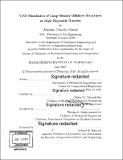| dc.contributor.advisor | Michael S. Triantafyllou. | en_US |
| dc.contributor.author | Olaoye, Abiodun Timothy. | en_US |
| dc.contributor.other | Massachusetts Institute of Technology. Department of Mechanical Engineering. | en_US |
| dc.date.accessioned | 2019-09-17T22:44:29Z | |
| dc.date.available | 2019-09-17T22:44:29Z | |
| dc.date.copyright | 2019 | en_US |
| dc.date.issued | 2019 | en_US |
| dc.identifier.uri | https://hdl.handle.net/1721.1/122262 | |
| dc.description | Thesis: Ph. D. in Mechanical Engineering and Computation, Massachusetts Institute of Technology, Department of Mechanical Engineering, 2019 | en_US |
| dc.description | Cataloged from PDF version of thesis. | en_US |
| dc.description | Includes bibliographical references (pages 129-131). | en_US |
| dc.description.abstract | Slender cylindrical structures are common in many offshore engineering applications such as floating wind turbines and subsea risers. These structures are vulnerable to flow-induced vibrations under certain environmental conditions which impacts their useful life. Flow-induced vibrations have been widely studied both experimentally and numerically especially at low Reynolds number. However, many questions remain unanswered in detail regarding the effects of high Re on structural responses and fluid-structure interaction (FSI) phenomena such as lock-in for different design configurations. Furthermore, under realistic environmental conditions, the oncoming flow velocity profile may not be uniform. In such scenarios, effects of large changes in Re along span on nature of structural responses may be significant. | en_US |
| dc.description.abstract | This research project is focused on computational fluid dynamics (CFD) simulation of slender structures under realistic oncoming ocean currents with relatively higher Reynolds number (Re >/- 10,000) compared to existing literature. Computational methods for investigating FSI phenomena are limited by high Reynolds number, complex flow profiles, low mass ratio and large aspect ratio of structures. Despite these challenges, numerical approach potentially offers more detailed analysis and ease of parameter tuning to investigate unique cases too expensive to conduct in experiments. Therefore, advances in research is increasingly supported by numerical modeling. In the framework of Fourier Spectral/hp element method implemented in NEKTAR code, an entropy-based viscosity method (EVM) was employed to account for turbulence effects not captured by the numerical grid and fictitious added mass method was utilized in the structure solver to handle low mass ratio problems. | en_US |
| dc.description.abstract | Also, the mapping-enabled smoothed profile method (SPM) in addition to already stated techniques was used to simulate cases involving buoyancy modules. A thorough verification and validation of the current algorithms was carried out for stationary cylinders with uniform cross-sections, flexibly-mounted rigid cylinders and flexible cylinders. Major contributions include EVM enabled simulations of dynamic responses of flexibly-mounted rigid cylinders with low mass ratio in higher Reynolds number uniform flows (Re = 140,000) compared with existing literature thereby yielding numerically novel response maps. The new results provide more insights on the role of Re in amplitude responses and FSI phenomena associated with vortex-induced vibrations in practical applications. Another major contribution is the investigation in detail of complex flows past a flexible cylinder at Re[subscript max] </- 11,000 which is higher than existing literature (Re[subscript max] 2000). | en_US |
| dc.description.abstract | The relatively large change in Re along span revealed new fluid-structure energy transfer behavior in linearly and exponentially sheared flows. | en_US |
| dc.description.statementofresponsibility | by Abiodun Timothy Olaoye. | en_US |
| dc.format.extent | 131 pages | en_US |
| dc.language.iso | eng | en_US |
| dc.publisher | Massachusetts Institute of Technology | en_US |
| dc.rights | MIT theses are protected by copyright. They may be viewed, downloaded, or printed from this source but further reproduction or distribution in any format is prohibited without written permission. | en_US |
| dc.rights.uri | http://dspace.mit.edu/handle/1721.1/7582 | en_US |
| dc.subject | Mechanical Engineering. | en_US |
| dc.title | CFD simulation of long slender offshore structures at high Reynolds number | en_US |
| dc.title.alternative | Computational fluid dynamics simulation of long slender offshore structures at high Reynolds number | en_US |
| dc.type | Thesis | en_US |
| dc.description.degree | Ph. D. in Mechanical Engineering and Computation | en_US |
| dc.contributor.department | Massachusetts Institute of Technology. Department of Mechanical Engineering | en_US |
| dc.identifier.oclc | 1117711317 | en_US |
| dc.description.collection | Ph.D.inMechanicalEngineeringandComputation Massachusetts Institute of Technology, Department of Mechanical Engineering | en_US |
| dspace.imported | 2019-09-17T22:44:25Z | en_US |
| mit.thesis.degree | Doctoral | en_US |
| mit.thesis.department | MechE | en_US |
